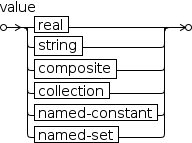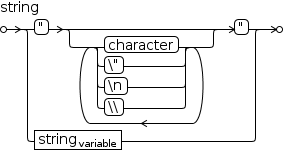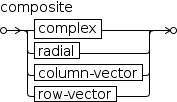2.3.2 Numbers and Other Values
A

2.3.2.1 Numeric
Numeric values represent magnitude.
Simple numeric values are stored internally using 64-bit
IEEE representation with about sixteen digits of base-10 precision.
Other numeric values include rational numbers like 






(a) Decimal

(b) Exponent
To keep the display clean, numbers with fractional parts are displayed with at most three
digits of precision. Scientific notation with at most three digits of precision
is used if a real value
cannot be displayed within this constraint. Although the display might not present the
complete value, the text-output area always contains the number with
the maximum precision. A number with a large number of digits in the
fraction like the left operand in
1.23456^10
will display as



(a) radix

(d) ɽ-Exponent
Number bases other than 10
use the notation given in Figure 2.14.
A number with a non-decimal base is written starting with the base (in decimal)
followed by the radix symbol “ɽ” (or “r”) followed by the number using radix-ɽ digits.
Radix-ɽ digits include any digit ranging from 0 up to but not including the base.
Digits beyond 9 are taken from the aphabet, starting with A for 10 and ignoring case.
For example, a hexadecimal integer is entered as 16ɽ12AB and displays as

Radix numbers can also contain a radix point. For example, 25.25 in
binary is entered as 2r11001.01 and displayed as 


When the radix is greater than 14, the letters “e” and “E” become valid
radix digits, rendering them unavailable to introduce
an exponent. For this reason, a third exponent glyph “℮” is used to introduce an exponent.
Contrast the input form 16ɽbcde10 of 

Radix digits are limited by the alphabet. Digits for number bases above 36 cannot be represented by the syntactic techniques described here.
Boolean values are a façade for real values 0 and 1. They are displayed as ⊤ for true and ⊥ for false. Boolean values are produced by comparison and containment operators, whose operands can be of any type. They are also produced by Boolean operators, whose operands are Boolean.
Complex numbers have both a composite form (see §2.3.2.3) called “complex-I”
and a simple form called “complex-J”.
The latter has the notation ⅉ and for the most part acts just like any other real constant
except that it cannot, of course, be evaluated.
However, the product 

Mathematicians make extensive use of special values called
| Symbol | Name | Description |
| ℼ | pi | ratio of circumference to diameter |
| ⅇ | Euler's Number | the base of the natural logarithms |
| ⅉ |  |
Complex-J |
| ℽ | Euler–Mascheroni constant | the limiting difference between the harmonic series |
| ∞ | Infinity | represents computationally infeasible large numbers |
| ¿ | Indeterminate | represents computationally unobtainable values |
| ⊤ | True | produced by manifest Boolean expressions |
| ⊥ | False | produced by manifest Boolean expressions |
| ĉ | constant | the constant of integration |
2.3.2.2 Strings
Strings are immutable sequences of characters. They are entered by enclosing the sequence in quotation marks. A small number of special characters are escaped by the backslash character: newline, quotation mark and backslash itself.

Strings can be composed by concatenation and partitioned by ↑ (substring) and ↓ (inverse substring, i.e, remove substring). They can be indexed and their length can be determined by the cardinality operator.
2.3.2.3 Composites






The display form of these values
differs from the input form. Here are some examples of
composite values:
(1,2)ⅈ
is the complex value




| Input form | Simple form | Display form |
| (0,0)i | 0i |  |
| (0,1)i | 1i |  |
| (0,2)i | 2i |  |
| (1,1)i |  |
|
| (1,-1)i |  |
|
| (1,0)i | 1 |  |
Radial literals consist of a magnitude and at least one angle. A single-angle radial can be interpreted as a polar coordinate and a two-angle radial can be interpreted as a spherical coordinate.
2.3.2.4 Collections




Like other values, a collection can be associated with a variable.
Mathematicians make use of special variable names that are used to refer to special sets that characterize numbers. These are given in Figure 2.20. The can be used with the set-inclusion operator ∈ to determine if a real meets some criterion.



| Symbol | Description |
| ℙ | the set of positive prime numbers |
| ℕ | the set of natural numbers (non-negative integers) |
| ℤ | the set of integers, positive, negative and zero |
| ℚ | the set of rational numbers |
| ℝ | the set of real numbers |
| ℂ | the set of complex numbers |